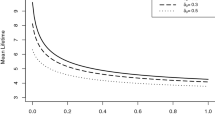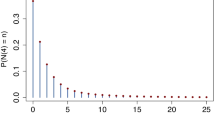Abstract
We attempt to provide a brief introduction to the extensive area of shock model research in reliability theory. Possible connections with application areas such as risk analysis, inventory control and biometry are indicated. Important concepts and tools for proving shock model results such as total positivity and variation diminishing property (VDP) are introduced. Most of the important results concerning nonparametric ageing classes arising from shock models are summarized, and some typical techniques of proof are emphasized. A variety of scenarios with diverse arrival processes such as homogeneous Poisson process, nonhomogeneous Poisson process, stationary and nonstationary pure birth processes are considered. A few interesting results related to cumulative damage models are also discussed.
Access this chapter
Tax calculation will be finalised at checkout
Purchases are for personal use only
Similar content being viewed by others
References
A-Hameed, M., & Proschan, F. (1975). Shock models with underlying birth process. Journal of Applied Probability, 12(1), 18–28.
A-Hameed, M. S., & Proschan, F. (1973). Nonstationary shock models. Stochastic Processes and their Applications, 1, 383–404.
Abouammoh, A. M., & Ahmed, A. N. (1988). The new better than used failure rate class of life distributions. Advances in Applied Probability, 20, 237–240.
Abouammoh, A. M., Hendi, M. I., & Ahmed, A. N. (1988). Shock models with NBUFR and NBAFR survivals. Trabajos De Estadistica, 3(1), 97–113.
Akama, M., & Ishizuka, H. (1995). Reliability analysis of Shinkansen vehicle axle using probabilistic fracture mechanics. JSME international journal. Ser. A, Mechanics and Material Engineering, 38(3), 378–383.
Anderson, K. K. (1987). Limit theorems for general shock models with infinite mean intershock times. Journal of Applied Probability, 24(2), 449–456.
Anis, M. (2012). On some properties of the IDMRL class of life distributions. Journal of Statistical Planning and Inference, 142(11), 3047–3055.
Barlow, R. E., & Proschan, F. (1965). Mathematical theory of reliability. New York: Wiley.
Barlow, R. E., & Proschan, F. (1975). Statistical theory of reliability and life testing. Rinehart and Winston, New York: Holt.
Belzunce, F., Ortega, E.-M., & Ruiz, J. M. (2007). On non-monotonic ageing properties from the Laplace transform, with actuarial applications. Insurance: Mathematics and Economics, 40(1), 1–14.
Bogdanoff, J. L., & Kozin, F. (1985). Probabilistic models of cumulative damage. New York: Wiley.
Bryson, M. C., & Siddiqui, M. M. (1969). Some criteria for aging. Journal of the American Statistical Association, 64, 1472–1483.
Campean, I. F., Rosala, G. F., Grove, D. M., & Henshall, E. (2005). Life modelling of a plastic automotive component. In Proceedings of Annual Reliability and Maintainability Symposium, 2005 (pages 319–325). IEEE.
Dasgupta, A., & Pecht, M. (1991). Material failure mechanisms and damage models. IEEE Transactions on Reliability, 40(5), 531–536.
Durham, S., & Padgett, W. (1997). Cumulative damage models for system failure with application to carbon fibers and composites. Technometrics, 39(1), 34–44.
Ebrahimi, N. (1999). Stochastic properties of a cumulative damage threshold crossing model. Journal of Applied Probability, 36(3), 720–732.
Esary, J. D., Marshall, A. W., & Proschan, F. (1973). Shock models and wear processes. Annals of Probability, 1, 627–649.
Feller, W. (1968). An introduction to probability theory and its applications (Vol. 1). New York: Wiley.
Garbatov, Y., & Soares, C. G. (2001). Cost and reliability based strategies for fatigue maintenance planning of floating structures. Reliability Engineering & System Safety, 73(3), 293–301.
Gertsbakh, I., & Kordonskiy, K. B. (2012). Models of failure. Springer Science & Business Media.
Glaser, R. E. (1980). Bathtub and related failure rate characterizations. Journal of the American Statistical Association, 75(371), 667–672.
Guess, F., Hollander, M., & Proschan, F. (1986). Testing exponentiality versus a trend change in mean residual life. Annals of Statistics, 14(4), 1388–1398.
Hollander, M., & Proschan, F. (1984). Nonparametric concepts and methods in reliability. In P. R. Krishnaiah & P. K. Sen (Eds.), Handbook of statistics (Vol. 4, pp. 613–655). Amsterdam: Elsevier Sciences.
Karlin, S. (1968). Total positivity, (Vol. 1). Stanford University Press.
Karlin, S., & Proschan, F. (1960). Pólya type distributions of convolutions. The Annals of Mathematical Statistics, 721–736.
Khan, R. A., Bhattacharyya, D., & Mitra, M. (2021). On classes of life distributions based on the mean time to failure function. Journal of Applied Probability, 58(2), in-press.
Klefsjö, B. (1981). HNBUE survival under some shock models. Scandinavian Journal of Statistics, 8, 39–47.
Klefsjö, B. (1983). A useful ageing property based on the Laplace transformation. Journal of Applied Probability, 20, 615–626.
Kochar, S. C. (1990). On preservation of some partial orderings under shock models. Advances in Applied Probability, 22(2), 508–509.
Lai, C. D., & Xie, M. (2006). Stochastic ageing and dependence for reliability. New York: Springer.
Loh, W. Y. (1984). A new generalization of the class of NBU distributions. IEEE Transactions on Reliability, R-33, 419–422.
Lukić, M., & Cremona, C. (2001). Probabilistic optimization of welded joints maintenance versus fatigue and fracture. Reliability Engineering & System Safety, 72(3), 253–264.
Marshall, A. W., & Olkin, I. (2007). Life distributions. New York: Springer.
Mitra, M., & Basu, S. (1994). On a nonparametric family of life distributions and its dual. Journal of Statistical Planning and Inference, 39, 385–397.
Mitra, M., & Basu, S. K. (1996). Shock models leading to non-monotonic ageing classes of life distributions. Journal of Statistical Planning and Inference, 55, 131–138.
Nakagawa, T. (2007). Shock and damage models in reliability theory. Springer Science & Business Media.
Padgett, W. (1998). A multiplicative damage model for strength of fibrous composite materials. IEEE Transactions on Reliability, 47(1), 46–52.
Pellerey, F. (1993). Partial orderings under cumulative damage shock models. Advances in Applied Probability, 25(4), 939–946.
Pérez-Ocón, R., & Gámiz-Pérez, M. L. (1995). On the HNBUE property in a class of correlated cumulative shock models. Advances in Applied Probability, 27(4), 1186–1188.
Petryna, Y. S., Pfanner, D., Stangenberg, F., & Krätzig, W. B. (2002). Reliability of reinforced concrete structures under fatigue. Reliability Engineering & System Safety, 77(3), 253–261.
Rolski, T. (1975). Mean residual life. Bulletin of the International Statistical Institute, 46, 266–270.
Satow, T., Teramoto, K., & Nakagawa, T. (2000). Optimal replacement policy for a cumulative damage model with time deterioration. Mathematical and Computer Modelling, 31(10–12), 313–319.
Shanthikumar, J. G., & Sumita, U. (1983). General shock models associated with correlated renewal sequences. Journal of Applied Probability, 20(3), 600–614.
Sobczyk, K., & Spencer, B, Jr. (2012). Random fatigue: From data to theory. Academic Press.
Sobczyk, K., & Trebicki, J. (1989). Modelling of random fatigue by cumulative jump processes. Engineering Fracture Mechanics, 34(2), 477–493.
Yamada, K. (1989). Limit theorems for jump shock models. Journal of Applied Probability, 26(4), 793–806.
Zacks, S. (1991). Introduction to reliability analysis. New York: Springer.
Acknowledgements
The authors are indebted to Professor Arnab K. Laha for his constant encouragement in making this article a reality and to Mr. Dhrubasish Bhattacharyya for some helpful discussions during the preparation of this manuscript.
Author information
Authors and Affiliations
Corresponding author
Editor information
Editors and Affiliations
Rights and permissions
Copyright information
© 2021 The Author(s), under exclusive license to Springer Nature Singapore Pte Ltd.
About this paper
Cite this paper
Mitra, M., Khan, R.A. (2021). Reliability Shock Models: A Brief Excursion. In: Laha, A.K. (eds) Applied Advanced Analytics. Springer Proceedings in Business and Economics. Springer, Singapore. https://doi.org/10.1007/978-981-33-6656-5_3
Download citation
DOI: https://doi.org/10.1007/978-981-33-6656-5_3
Published:
Publisher Name: Springer, Singapore
Print ISBN: 978-981-33-6655-8
Online ISBN: 978-981-33-6656-5
eBook Packages: Business and ManagementBusiness and Management (R0)




